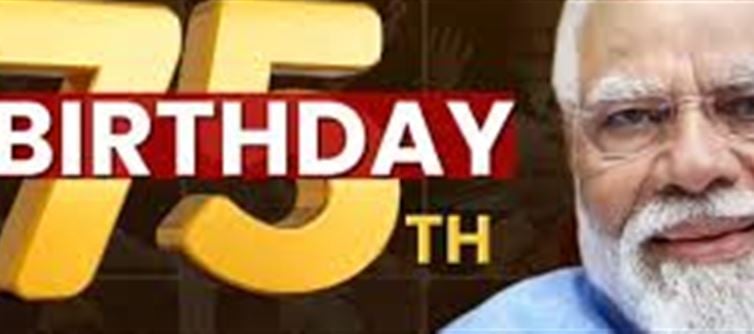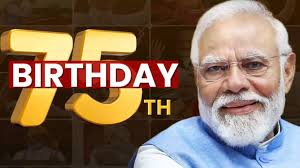
-

2020
-

Apple
-

Application
-

Bank
-

Banking
-

Bihar
-

BUSINESS
-

Cancer
-

Corporate
-

Delhi
-

Digital Wallet Platform
-

Event
-

Government
-

Gujarat - Gandhinagar
-

gulf countries
-

HEALTH
-

HTC
-

Huawei
-

India
-

Indian
-

Indians
-

Indore
-

INTERNATIONAL
-

jaishankar
-

Jammu and Kashmir - Srinagar/Jammu
-

job
-

Journey
-

Leader
-

LG
-

Lung cancer
-

Maldives
-

Mass
-

Minister
-

Motorola
-

Narendra
-

Nokia
-

Prime Minister
-

Pune
-

Redmi
-

Reliance
-

Russia
-

Samsung
-

september
-

Service
-

Sony
-

Subrahmanyam Jaishankar
-

Surat
-

UAE
-

World Cup
-

youth
Introduction
As prime minister narendra Modi celebrates his 75th birthday on september 17, 2025, india reflects on a political career defined by bold "firsts" that have transformed the nation’s governance, economy, and global standing. Born in 1950 in Vadnagar, gujarat, Modi’s journey from a tea seller’s son to a global statesman is a story of grit and vision. Over his eleven-year tenure as prime minister, starting in 2014, Modi has introduced landmark reforms that have redefined India’s trajectory. His policies—rooted in the principles of "Sabka Saath, Sabka Vikas, Sabka Vishwas" (Together with All, Development for All, Trust of All)—have prioritized inclusivity, modernization, and self-reliance. This article explores the transformative reforms that mark Modi’s legacy as a leader who reshaped India’s governance, economy, and diplomacy.
Governance Reforms: A New Paradigm
Modi’s governance philosophy, encapsulated in “Minimum government, Maximum Governance,” has streamlined administration, enhanced transparency, and empowered citizens. His reforms have introduced unprecedented efficiency and accountability.
1. wallet PLATFORM' target='_blank' title='digital-Latest Updates, Photos, Videos are a click away, CLICK NOW'>digital india and Aadhaar Integration
Reform: Launched in 2015, wallet PLATFORM' target='_blank' title='digital-Latest Updates, Photos, Videos are a click away, CLICK NOW'>digital india revolutionized governance through technology. The integration of Aadhaar (biometric ID) with the Jan Dhan Yojana (banking for all) and mobile connectivity—known as the JAM Trinity—enabled direct benefit transfers (DBT).
Impact: Over 520 million bank accounts opened, with ₹3.5 lakh crore transferred directly to beneficiaries, saving ₹3 lakh crore by curbing leakages. Apps like UMANG and MyGov (200 million downloads) have made government services accessible on smartphones.
First: india became the first major economy to implement a biometric-based welfare delivery system at this scale, reducing corruption and ensuring last-mile delivery.
2. Swachh Bharat Abhiyan
Reform: Initiated in 2014, this nationwide cleanliness campaign aimed to make india open defecation-free (ODF) and promote hygiene.
Impact: Over 110 million toilets were built by 2019, achieving ODF status for rural India. Urban cleanliness rankings, led by indore for seven consecutive years, transformed civic behavior.
First: The first mass movement of its kind, Swachh Bharat shifted cultural attitudes toward sanitation, with 90% of indians now prioritizing cleanliness, per surveys.
3. Abolition of Article 370
Reform: In 2019, Modi’s government revoked Article 370, integrating Jammu & kashmir fully into india by removing its special status.
Impact: Followed by ₹80,000 crore in development projects, the region saw improved infrastructure, tourism (1.5 crore visitors in 2024), and reduced militancy. The move also enabled equal application of indian laws.
First: The first time in seven decades that Jammu & kashmir was brought under a unified constitutional framework, fostering national integration.
4. Insolvency and Bankruptcy Code (IBC)
Reform: Enacted in 2016, IBC streamlined corporate debt resolution, strengthening India’s financial system.
Impact: Recovered ₹3 lakh crore from defaulters, boosting banking sector health. India’s ease-of-doing-business ranking for resolving insolvency jumped from 136th to 52nd.
First: India’s first comprehensive framework for bankruptcy, aligning with global standards and attracting investor confidence.
Governance Reform
Key Metric
Impact
Digital India
520M accounts
₹3.5L Cr in DBT
Swachh Bharat
110M toilets
ODF rural India
Article 370
₹80,000 Cr projects
1.5 Cr tourists
IBC
₹3L Cr recovered
52nd in insolvency ranking
Economic Reforms: Powering Growth
Modi’s economic vision transformed india from a “fragile five” economy to the world’s fifth-largest, with a GDP of $4.18 trillion in 2025. His reforms have fostered self-reliance and global competitiveness.
1. Goods and services Tax (GST)
Reform: Implemented in 2017, GST replaced a complex web of state taxes with a unified system.
Impact: Monthly collections reached ₹1.8 lakh crore by 2025, boosting revenue and compliance. It simplified business operations, contributing to 7%+ annual GDP growth.
First: India’s first single-tax regime, harmonizing a $3 trillion market and reducing logistics costs by 15%.
2. Make in india and Atmanirbhar Bharat
Reform: Launched in 2014, Make in india promoted manufacturing, followed by Atmanirbhar Bharat in 2020 to foster self-reliance post-COVID.
Impact: Attracted $650 billion in FDI, created 100,000+ startups, and tripled unicorns to 110. mobile exports soared from $1.6 billion to $15 billion. Defense production hit ₹1 lakh crore, with exports to 80 countries.
First: India’s first concerted push to become a global manufacturing hub, reducing import dependency in electronics and defense.
3. Agricultural Reforms
Reform: Schemes like PM KISAN (2019) and increased Minimum Support Prices (MSP) supported farmers, alongside the 2020 farm laws (later repealed due to protests).
Impact: ₹2.5 lakh crore disbursed to 120 million farmers via PM KISAN. Agricultural exports rose to $50 billion, with tech-driven farming boosting yields by 20%.
First: The first direct income support scheme for farmers, ensuring financial stability for rural households.
4. Renewable Energy Push
Reform: Modi scaled up renewable energy through the international Solar Alliance and National Solar Mission.
Impact: Renewable capacity grew from 76 GW to 200 GW, with solar at 85 GW. india is on track for 500 GW by 2030, reducing emissions intensity by 33% since 2005.
First: India’s first global climate initiative (ISA), now spanning 120 countries, positioning india as a green energy leader.
Diplomacy: Elevating India’s Global Image
Modi’s foreign policy has redefined india as a global power, balancing strategic autonomy with proactive partnerships.
1. Vaccine Maitri
Reform: During COVID-19, india supplied 200 million vaccine doses to 100+ countries under Vaccine Maitri (2020-2022).
Impact: Strengthened India’s image as a “pharmacy of the world,” earning praise from leaders like Vietnam’s PM: “India’s generosity saved lives.”
First: The first time india led a global health initiative at this scale, enhancing soft power.
2. G20 Presidency (2023)
Reform: Modi’s “One Earth, One Family, One Future” theme emphasized global south priorities.
Impact: Secured African Union membership and the New delhi Declaration, resolving geopolitical divides. India’s leadership drew 1 million delegates to 200+ events.
First: India’s first G20 presidency, showcasing its diplomatic prowess and cultural heritage.
3. Neighborhood First and Act East
Reform: Strengthened ties with neighbors (Bhutan, Maldives) and ASEAN nations through infrastructure investments and defense pacts.
Impact: india invested $5 billion in regional projects, earning honors like Bhutan’s Order of the Druk Gyalpo. QUAD partnerships countered China’s influence.
First: The first structured policy to deepen regional connectivity, making india a linchpin in Indo-Pacific security.
4. Strategic Global Alliances
Reform: Deepened ties with the US, France, and uae through high-level visits and trade deals.
Impact: Secured $20 billion in US defense deals and a $100 billion India-UAE trade target by 2030. Modi received France’s Grand Cross and UAE’s Order of Zayed.
First: India’s first comprehensive alignment with Western and gulf powers, balancing relations with russia and China.
Birthday Celebrations: service and Legacy
Modi’s 75th birthday is marked by Sewa Pakhwada (September 17–October 2), reflecting his ethos of service:
Health Initiatives: Launch of Swasth Nari, Sashakt Parivar Abhiyaan for women’s health, including cervical cancer vaccinations.
Blood Donation Drives: 54,000 units collected in gujarat under “Namo ke Naam Raktdaan.”
Cleanliness Campaigns: Nationwide Swachh Bharat events in 5,000 cities.
Inaugurations: A textile park in Dhar, Madhya Pradesh, and potential visits to bihar for Pitru Paksha Mela.
Global leaders, from maldives President Muizzu to Japan’s PM Ishiba, sent greetings. Cultural events include a surat exhibition and a rescheduled pune drone show. Citizens shared #MyModStory on X, with tributes like Messi’s signed world cup jersey.
Challenges and Future Vision
Despite successes, challenges like unemployment (7% urban rate), rural distress, and social cohesion persist. Modi’s third term focuses on:
Viksit Bharat @2047: A $10 trillion economy by India’s 100th independence year.
Skill india 2.0: Training 20 million youth for global job markets.
Tech and AI Leadership: Positioning india as an AI hub with $50 billion investments.
As External Affairs minister S. jaishankar noted, “Modi’s reforms have made india a confident, global player.”
Conclusion
At 75, narendra Modi’s legacy is defined by firsts that have reshaped India: from wallet PLATFORM' target='_blank' title='digital-Latest Updates, Photos, Videos are a click away, CLICK NOW'>digital governance to economic self-reliance and global leadership. His reforms have lifted 250 million out of poverty, built world-class infrastructure, and positioned india as a geopolitical force. As the nation celebrates his birthday, it honors a leader whose vision has transformed dreams into reality, setting the stage for a Viksit Bharat by 2047.
Happy 75th Birthday, PM Modi—your reforms inspire a billion aspirations.
Disclaimer:
The views and opinions expressed in this article are those of the author and do not necessarily reflect the official policy or position of any agency, organization, employer, or company. All information provided is for general informational purposes only. While every effort has been made to ensure accuracy, we make no representations or warranties of any kind, express or implied, about the completeness, reliability, or suitability of the information contained herein. Readers are advised to verify facts and seek professional advice where necessary. Any reliance placed on such information is strictly at the reader’s own risk.




 click and follow Indiaherald WhatsApp channel
click and follow Indiaherald WhatsApp channel